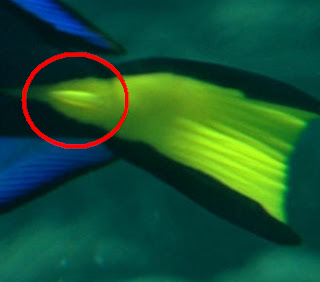Visitor: "You know that blue fish...?"
Staff: "Ahh yes, it's the bird nose wrasse."
Everyone knows the blue fish that is Dory from Finding Nemo (Regal Tang), the small devil damsels and yellow tail damsels are also blue fish, and even though they look pretty, no one wants to know about them.
But this blue fish; the bird nose wrasse (Gomphosus varius) gets a lot of enquirers and look at it!
Why wouldn't it?
Many people are just content knowing the name of this fish, though many more want to know "What's up with that nose?" This species has a long snout, you may make out that it looks a growth is growing on that snout. It's really common for these fish to develop tumors on their nose, this happens in the wild also. They have long snouts because they use them to stick between rocks and crevices to pick away at any crustaceans like small crabs hiding away in there. Rocks and crevices can be sharp which irritates their nose causing this growth. You may be wondering if it's serious. It can be but only if the growth interrupts their feeding.
As you can see this is a nice healthy fish, he eats well and isn't skinny. We do have the option to operate if the growth becomes a problem, we have a vet that can perform the operation if the need be. But, there's nothing to worry about for now. He's a fine strong healthy fish that enjoys his food. He's doing fine. I say "he" because this blue fish is a boy.
You can tell if the bird nose wrasse is a boy or a girl just by the colour. The blue ones are boys, the pinky/orange/browny ones are girls:
It would be pretty easy to look at this fish and decide it was a different species altogether. But no, she's a bird nose wrasse who hasn't developed a tumor. Both swim together in our Lagoon tank.
Not the information you were looking for? Try Fishbase.org























.JPG)
.JPG)

.JPG)